 Secondary Classrooms
10 Texts to Celebrate The Life and Legacy of Dr. Martin Luther King, Jr.
Secondary Classrooms
10 Texts to Celebrate The Life and Legacy of Dr. Martin Luther King, Jr.
Honor the achievements of Dr. Martin Luther King, Jr. in your classroom with historical biographies, primary source documents, speeches, and more.
CommonLit’s online digital literacy program provides teachers with access to thousands of free texts and comprehension questions. In this blog post, we will highlight texts you can use to celebrate Martin Luther King, Jr. Day in your classroom. These texts could also be used during Black History Month, in a unit on the Civil Rights Movement, or throughout the year.
“Dreams of Freedom” by Barbara Radner by Laurie Wallmark (4th Grade)
In this story, Wallmark shares her experience traveling with her white family to the March on Washington. Throughout this nonfiction narrative, Wallmark shares what it was like to witness Dr. King's "I Have a Dream" speech as a child, and the profound impact it had on her. Wallmark also reflects on her friendship with Amy, whose family faced housing discrimination because they were Black. Their friendship helps Wallmark understand the unfair treatment people were protesting at the March.
Ask students to find evidence in the text with Assessment Question 4, "Which detail shows that Reverend Doctor Martin Luther King Jr.'s speech had a powerful effect on people?"
“Dr. Martin Luther King Jr., Changing America” by Barbara Radner (5th Grade)
This informational text outlines Dr. King’s life and accomplishments, with a focus on his beliefs in equality and nonviolence. The article emphasizes the broad influence Dr. King had, and the important social changes that his work brought forth.
Engage students in meaningful discussion about protest and social change by asking Discussion Question 1, “Why is it important that Dr. King used nonviolent protests to create social change? Are there other ways people create social change? Which ones do students think are the best, and why?”
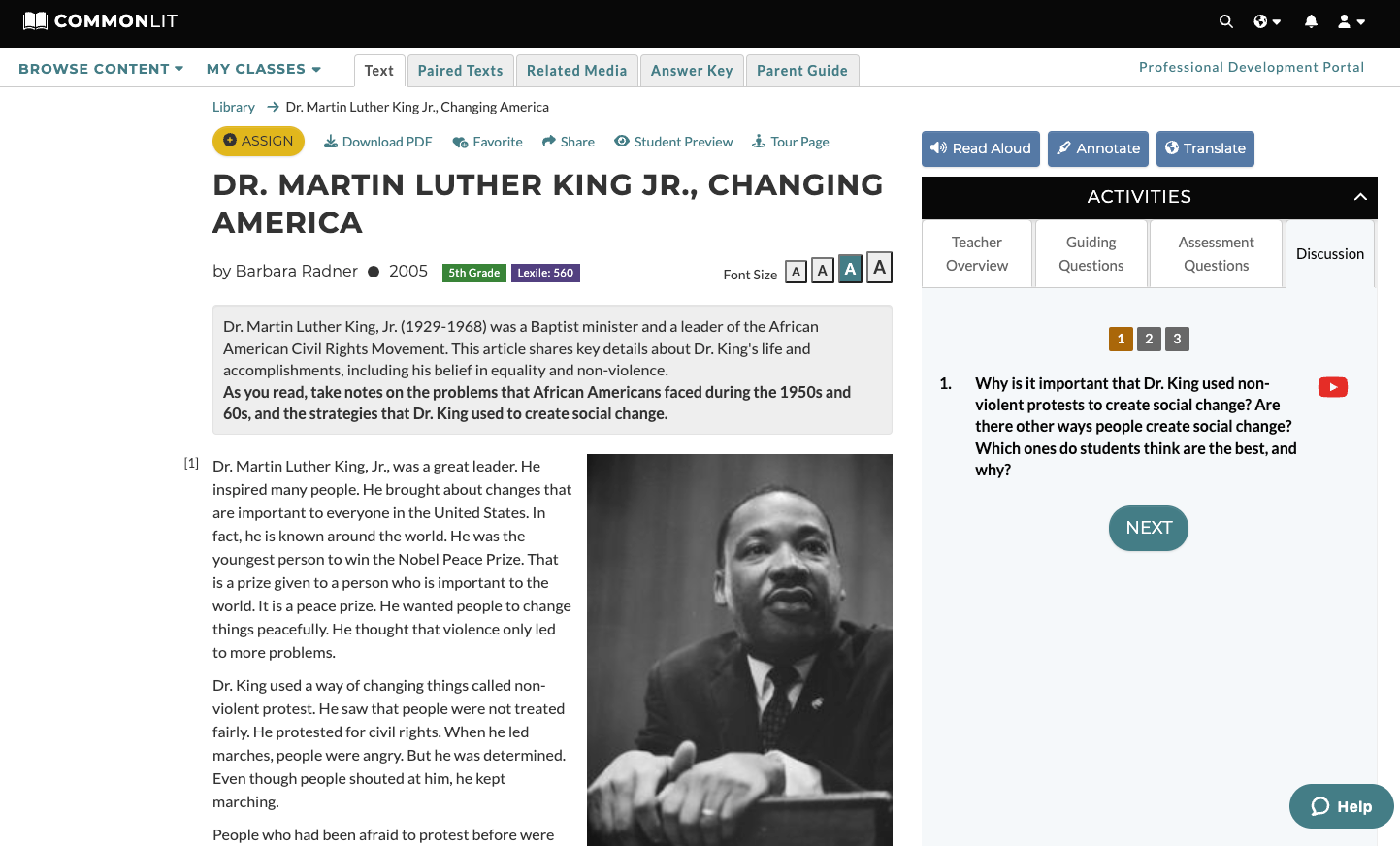
“Sharing a Dream” by Jim Haskins (5th Grade)
This text provides a clear summary of the life and career of Dr. King. Haskins gives background information on the country’s racial climate in the 1940s to 1960s, and notes that Dr. King was inspired by Mahatma Gandhi’s peaceful protests.
Teachers can present the video “Barack Obama Deeply Influenced by Mahatma Gandhi” from the Related Media tab. Then, have students reflect on why these two Black American leaders were influenced by Gandhi’s actions and philosophy of nonviolence and how this drove their actions as leaders.
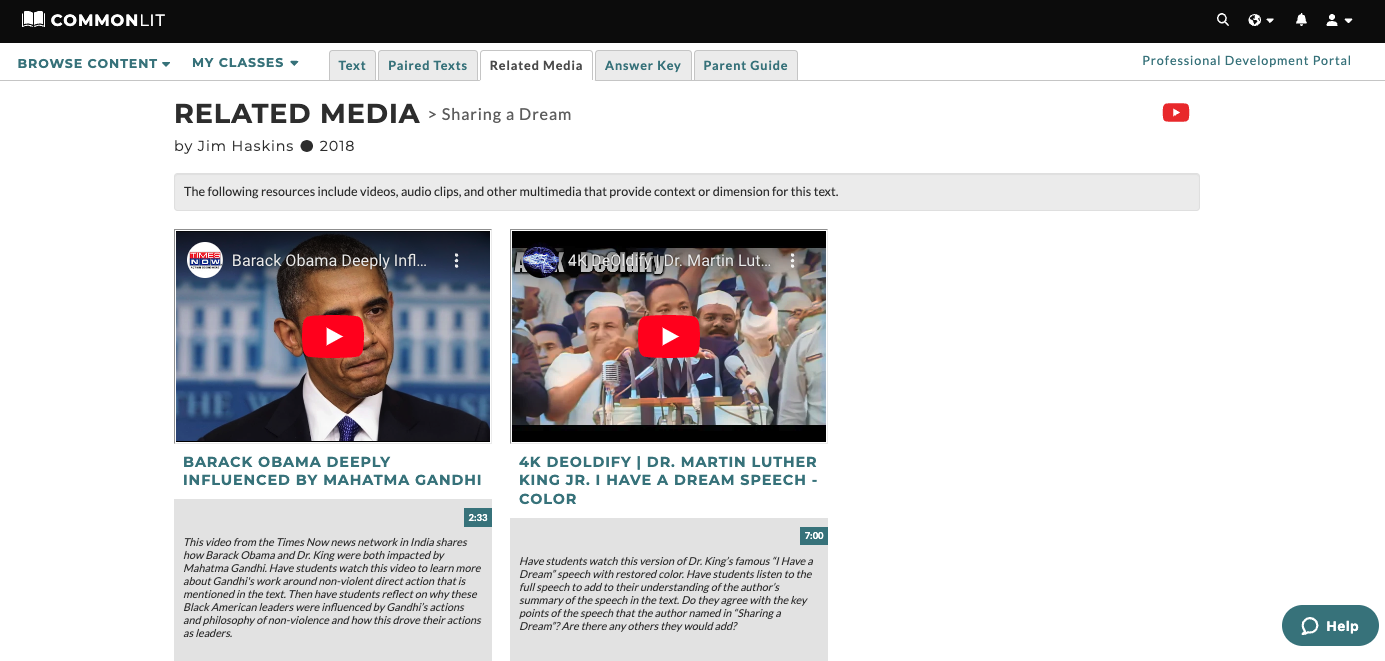
“Martin Luther King, Jr.” by USHistory.org (7th Grade)
This biographical text details the life and work of Dr. King, including his precocious childhood, his graduation from college at the impressive age of fifteen, his impactful work with nonviolent protest during the Civil Rights Movement, his untimely assassination, and his lasting legacy.
Have students read this text alongside “The Sit-In Movement,” from the Paired Texts tab, to provide them with more information regarding nonviolent protests during the Civil Rights Movement. Ask students, “How do the various forms of nonviolent protests depicted in the two texts compare? Do you think some forms of nonviolent protest are more effective than others?”
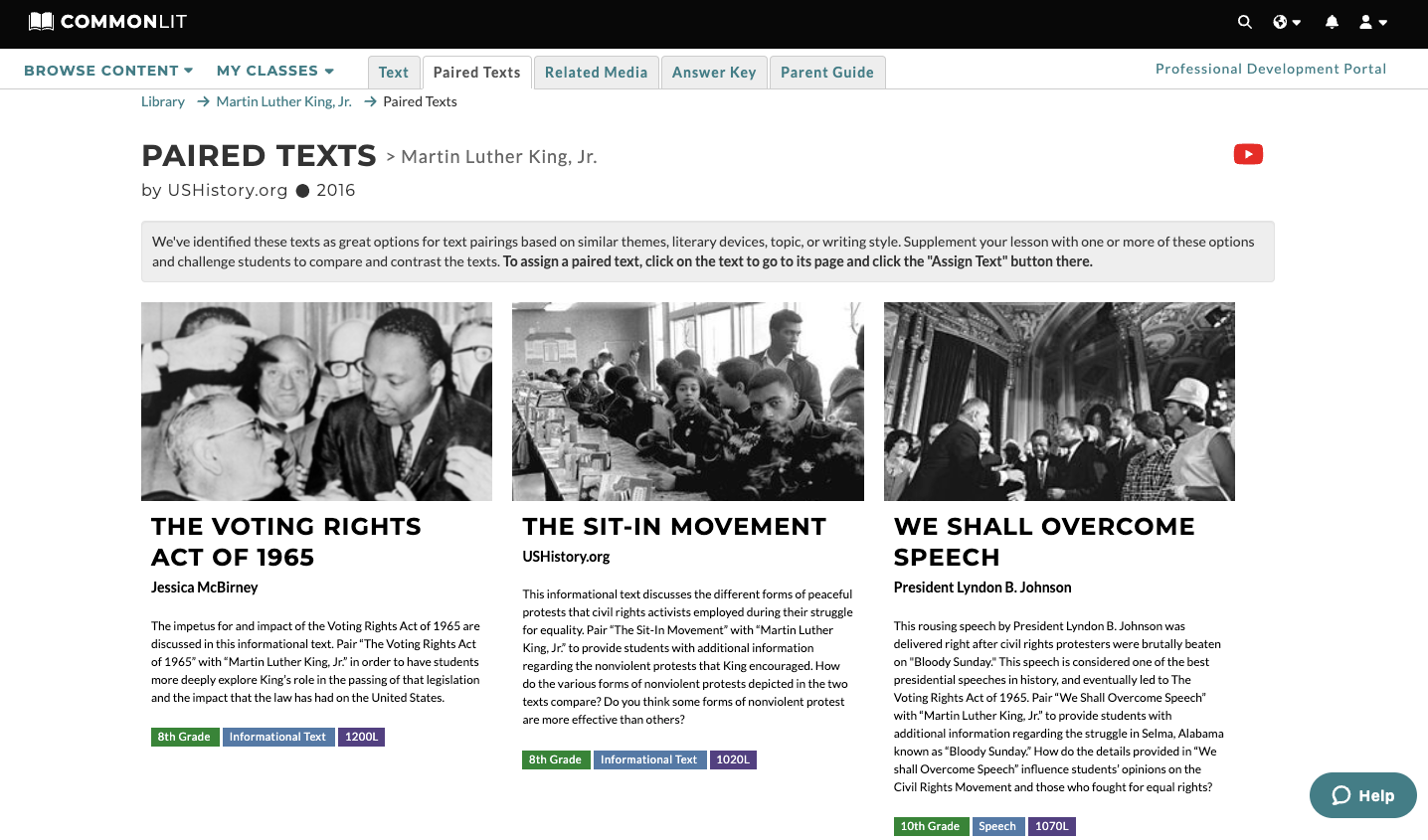
“RFK’s Speech Following the Death of MLK” by Senator Robert F. Kennedy (8th Grade)
This speech was delivered by Senator Robert F. Kennedy following the assassination of Dr. King on April 4, 1968. Kennedy prompts Americans to respond to King’s death with compassion and unity.
Have students practice the key skill of identifying central ideas by answering Assessment Question 1, “Which of the following best identifies the central idea of this speech?”
“For King’s Adviser, Fulfilling The Dream ‘Cannot Wait’” by Michele Norris (8th Grade)
In this article, Dr. King's adviser, Clarence Jones, looks back on the famous March on Washington. Jones remembers helping organize the march, worrying about the threat of violence, and listening to the "I Have a Dream" speech from the stage.
Ask students to discuss Jones's point of view on Dr. King with Assessment Question 1, "Which statement best describes Clarence Jones's opinion of Dr. Martin Luther King, Jr.'s legacy?"
“I Have A Dream” by Dr. Martin Luther King, Jr. (9th Grade)
One of the most famous speeches in history was delivered by Dr. King on the steps of the Lincoln Memorial in August 1963. In this powerful address, Dr. King discusses the injustices of the past and his hopes for the future. This speech is ideal for classroom rhetorical analysis, especially the use of repetition, allusions, and figurative language.
Have students watch “Martin Luther King | ‘I Have a Dream’ Speech” from the Related Media tab to witness Dr. King’s delivery of the piece. Then, “ask students to discuss the tone that Martin Luther King, Jr. uses throughout his speech and what words he emphasizes. How does this contribute to the power of the message that King is hoping to impart on the nation?”
“Letter from Birmingham Jail” by Dr. Martin Luther King, Jr. (10th Grade)
Following a protest in Birmingham, Alabama in 1963, Dr. King was jailed for protesting along with many others. Upon receiving a letter condemning his efforts by a group of white religious leaders, Dr. King sent this letter in response. The letter argues that the presence of injustice necessitates a nonviolent response in order to repair the harms that exist in our society.
Assign Assessment Question 7, “How does Dr. King develop his claim that ‘one has a moral responsibility to disobey unjust laws’? Explain the evidence he provides and evaluate how this evidence supports his arguments.” Students will engage in deep critical thinking while practicing the key writing skills needed in open-ended response questions.
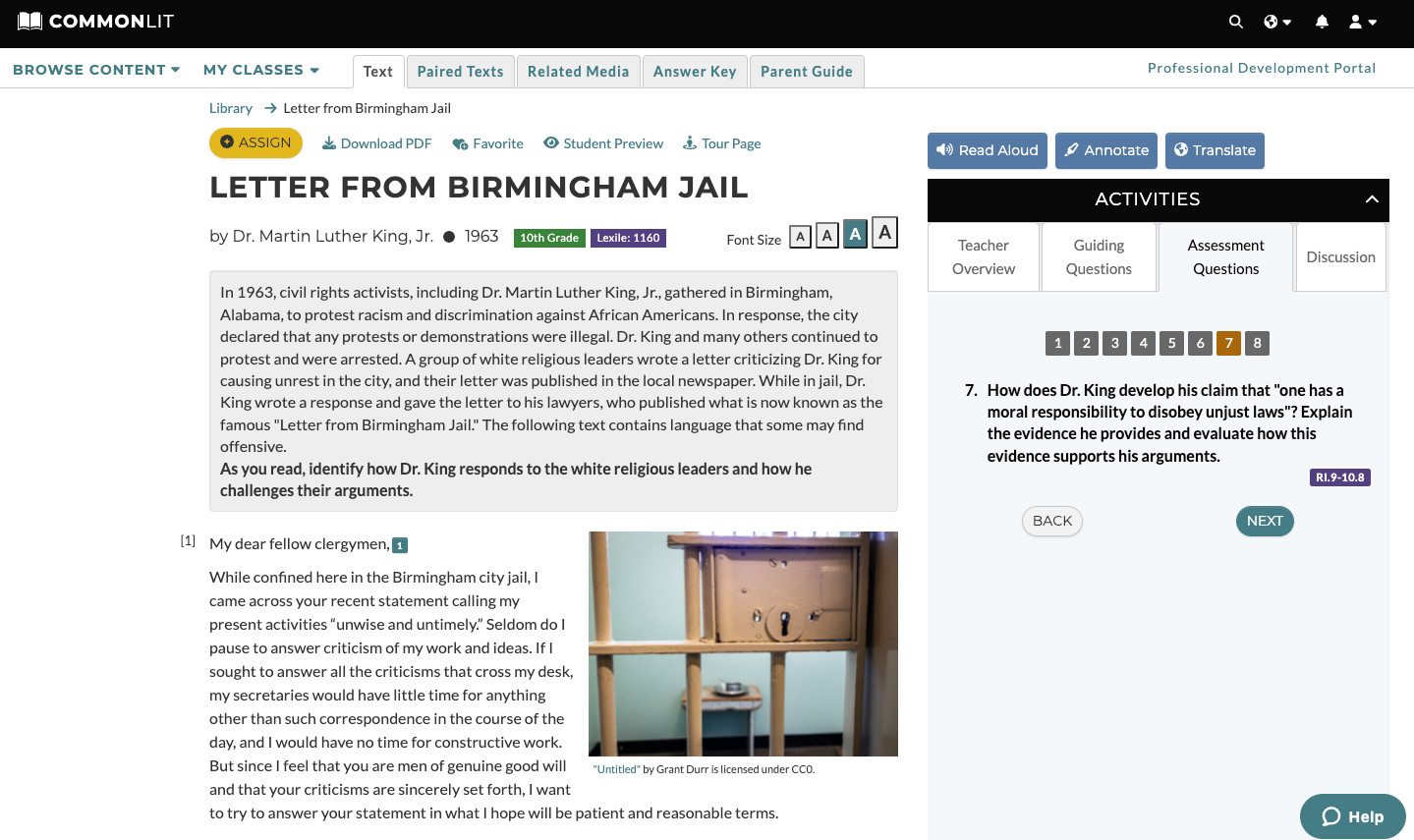
“Langston Hughes’ Hidden Influence on MLK” by Jason Miller (10th Grade)
Both Dr. King and Hughes were leaders of important movements and furthered the rights of African Americans. Dr. King and Hughes were friends but grew apart during the critical years of the Civil Rights Movement. In this informational text, Miller explores how echoes of the pair’s friendship can be found in each of their writings.
Have students read this text alongside Hughes’ “The Negro Speaks of Rivers” from the Paired Texts tab, “Ask students to discuss the themes Hughes explores in ‘The Negro Speaks of Rivers.’ How do students think Martin Luther King Jr. would have felt about this poem? Why?”
"Martin Luther King, Jr. Nobel Acceptance Speech" by Dr. Martin Luther King, Jr. (11th Grade)
Dr. King was awarded the Nobel Peace Prize for his contributions to the Civil Rights Movement. In his acceptance speech, Dr. King urges citizens and leaders to work together to reject violence and promote peace.
Have students discuss Discussion Question 3, “In your opinion, what are the effects of prejudice? How can we respond to prejudice? Cite evidence from this text, your own experience, and other literature, art, or history in your answer.”
Next Steps
Each year, people honor Dr. King’s legacy with a day of service on MLK Day. Discuss volunteering with your class by reading texts about making a difference. Engage students with “Hooray for Us!,” a short story about a group of students who come together to clean up a park or “The Wound Dresser,” a poem about a wartime hospital volunteer penned by Walt Whitman. Ask students why they believe MLK Day is celebrated with acts of service. How does this tradition honor Dr. King’s life and legacy?
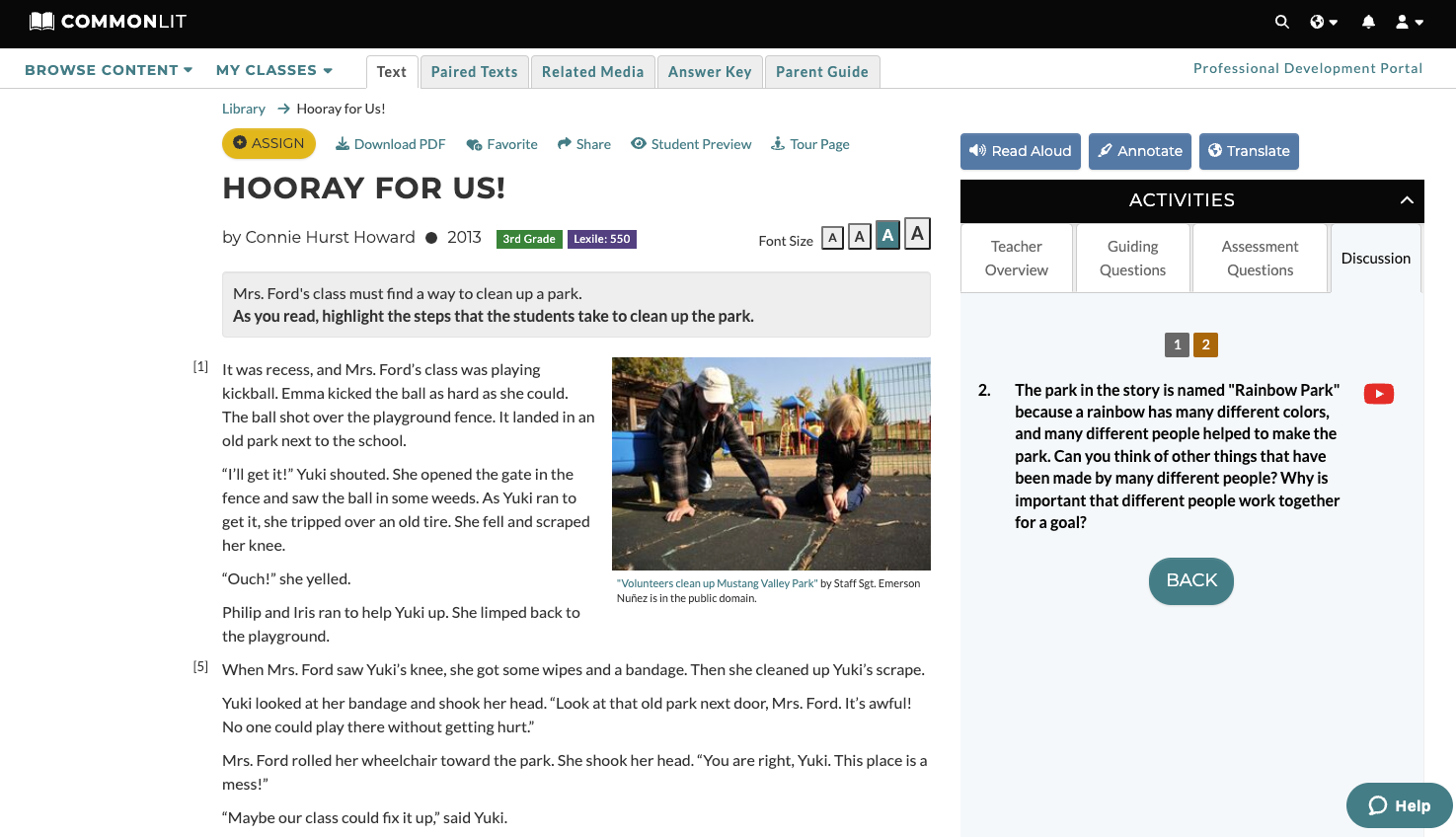
If you’re interested in learning all about CommonLit’s free online reading program, join one of our upcoming webinars!


